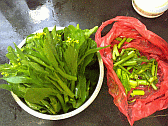|
|
| Fruit,
Vegetables and Gourds |
Ba Choi or
Bok Choi |
|
Ba Choi is a favourite leaf used in
Chinese cookery. It is notable for having very white
stems, which contrast markedly from the dark green leaves.
'choi' basically means 'leaf' aka lettuce or cabbage,
and Ba is Mainland Cantonese for white. Mandarin would
be 'Bei' for white. Many people refer to this as 'bok
choi', which is the common Hong Kong Cantonese spelling.
Ba Choi can be grown all year round in Guangdong, are
very quick and easy to grow, and are one of the permanent
features at nearly all wet markets and supermarkets.
They are sold in clumps by weight, and comprise small
plants that have perhaps eight or ten leaves in each.
They are usually picked just above the root and sold
the same day.
Supermarkets sell then just as clumps of leaves, but
in wet markets you can find them with small yellow flowers
also. These are preferred by Cantonese chef's and sought
out especially.
Cantonese cook all leaves, and even Iceberg lettuce!
This is related to their ideals of cleanliness, as boiling
water is considered to remove all harmful things.
Prepare the leaves simply by washing under running
water and breaking into individual leaves. Add
the yellow flowers if present, as these are delicious
also.
Cooking is very simple, with the leaves being
covered with water and brought to the boil. They
are then simmered for 5 minutes or less.
Recipes
Instead of simply serving as a vegetable, we recommend
you serve as an unusual and totally delicious
soup. This is virtually the same preparation and
cooking process, but this time you serve in the
juice. We would add a little more water than normal,
and sometimes a lot if you like it. Cook for perhaps
ten or 15 minutes on a low simmer, but remove
from the heat before the leaves turn into a flaccid
green goo (The way English people love to massacre
spinach).
They are done when the resulting liquid looks
opaque and has a slightly green look about it.
For western taste buds we would definitely recommend
adding a little ground white pepper for a delicate
flavour; or salt and black pepper for something
more thrilling.
|


|
|
|
|
This information is as supplied by ourselves, and ably
supported by our friends and various internet portals. |
|
| Search
this Website |
|
|
| Descriptions |


|
| Chinese Recipes |


|
|